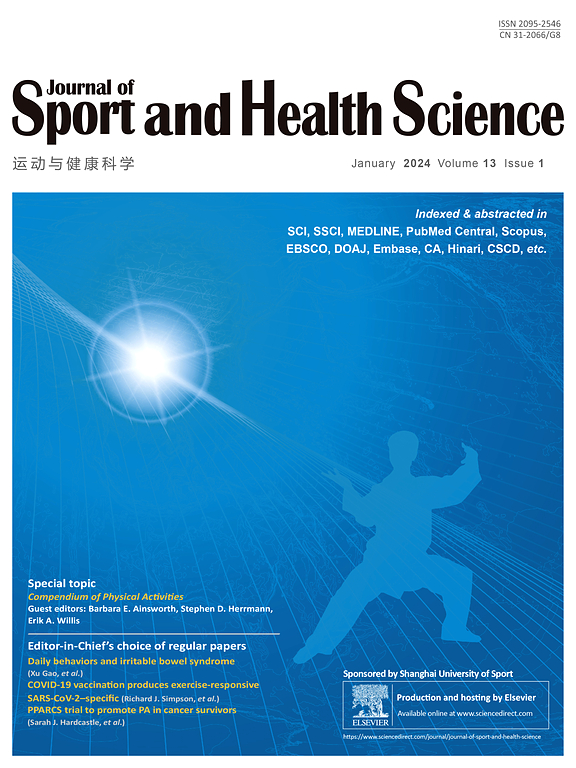Feasibility and clinical potential of exercise interventions during neoadjuvant chemoradiotherapy in patients with esophageal and rectal cancer.
IF 10.3
1区 医学
Q1 HOSPITALITY, LEISURE, SPORT & TOURISM
引用次数: 0
Abstract
BACKGROUND Exercise during neoadjuvant chemoradiotherapy (NCRT) has potential to mitigate treatment-related declines in physical fitness, and to improve clinical outcomes, including toxicity and tumor response. However, optimal frequency and timing of exercise remains to be determined. Therefore, this pilot trial aimed to assess feasibility of 2 different exercise interventions during NCRT in patients with esophageal and rectal cancer and to evaluate potential clinical effects. METHODS Patients were randomized into 1 of 3 study arms during NCRT: (a) 30-min aerobic exercise in-hospital within 1 h prior to each radiotherapy fraction (ExPR), (b) two 60-min supervised combined aerobic and resistance exercise sessions per week (AE+RE), and (c) usual care (UC). Feasibility was assessed by examining participation rate and exercise adherence. Intervention effects on physical fitness, health-related quality of life, treatment-related toxicity, and tumor response in patients with esophageal cancer were explored using regression analyses and 85% confidence intervals (85%CI). RESULTS Thirty-seven patients with esophageal cancer (participation rate: 45%) and 2 patients with rectal cancer (participation rate: 14%) were included. Median session attendance was 98% (interquartile range (IQR): 96-100) in the ExPR and 78% (IQR: 33-100) in the AE+RE group. We found clinically relevant benefits of exercise on maximal oxygen uptake (VO2max)(ExPR: β = 9.7 mL/kg/min, 85%CI: 6.9-12.6; AE+RE: β = 5.6 mL/kg/min, 85%CI: 2.6-8.5) and treatment-related toxicity (ExPR: β = -2.8, 85%CI: -5.4 to -0.2; AE+RE: β = -2.6, 85%CI: -5.3 to 0.0). Additionally, good tumor response was found in 70% in AE+RE and ExPR vs. 55% in UC (OR = 1.9, 85%CI: 0.5-7.7). CONCLUSION Starting prehabilitation during NCRT is feasible, can increase starting fitness of traditional pre-surgical programs, and has potential to improve clinical outcomes.食管癌和直肠癌患者新辅助放化疗中运动干预的可行性和临床潜力。
背景:在新辅助放化疗(NCRT)期间进行锻炼有可能减轻治疗相关的身体健康下降,并改善临床结果,包括毒性和肿瘤反应。然而,最佳的运动频率和时间仍有待确定。因此,本试验旨在评估食管癌和直肠癌患者NCRT期间2种不同运动干预的可行性,并评估潜在的临床效果。方法在NCRT期间,将患者随机分为3个研究组:(a)每次放疗前1小时内住院30分钟有氧运动(ExPR), (b)每周两次60分钟有氧和阻力联合运动(AE+RE), (c)常规护理(UC)。可行性通过检查参与率和运动依从性来评估。采用回归分析和85%可信区间(85% ci)探讨干预对食管癌患者体质、健康相关生活质量、治疗相关毒性和肿瘤反应的影响。结果纳入食管癌患者37例(参与率45%),直肠癌患者2例(参与率14%)。ExPR组的中位出勤率为98%(四分位数范围(IQR): 96-100), AE+RE组的中位出勤率为78% (IQR: 33-100)。我们发现运动对最大摄氧量(VO2max)的临床相关益处(ExPR: β = 9.7 mL/kg/min, 85%CI: 6.9-12.6;AE+RE: β = 5.6 mL/kg/min, 85%CI: 2.6-8.5)和治疗相关毒性(exp: β = -2.8,85%CI: -5.4至-0.2;AE+RE: β = -2.6,85%CI: -5.3 ~ 0.0)。此外,AE+RE和ExPR组的肿瘤反应良好率为70%,UC组为55% (OR = 1.9,85%CI: 0.5-7.7)。结论NCRT期间启动康复治疗是可行的,可以提高传统术前方案的启动适应度,具有改善临床疗效的潜力。
本文章由计算机程序翻译,如有差异,请以英文原文为准。
求助全文
约1分钟内获得全文
求助全文
来源期刊

Journal of Sport and Health Science
SPORT SCIENCES-
CiteScore
18.30
自引率
1.70%
发文量
101
审稿时长
22 weeks
期刊介绍:
The Journal of Sport and Health Science (JSHS) is an international, multidisciplinary journal that aims to advance the fields of sport, exercise, physical activity, and health sciences. Published by Elsevier B.V. on behalf of Shanghai University of Sport, JSHS is dedicated to promoting original and impactful research, as well as topical reviews, editorials, opinions, and commentary papers.
With a focus on physical and mental health, injury and disease prevention, traditional Chinese exercise, and human performance, JSHS offers a platform for scholars and researchers to share their findings and contribute to the advancement of these fields. Our journal is peer-reviewed, ensuring that all published works meet the highest academic standards.
Supported by a carefully selected international editorial board, JSHS upholds impeccable integrity and provides an efficient publication platform. We invite submissions from scholars and researchers worldwide, and we are committed to disseminating insightful and influential research in the field of sport and health science.
 求助内容:
求助内容: 应助结果提醒方式:
应助结果提醒方式:


